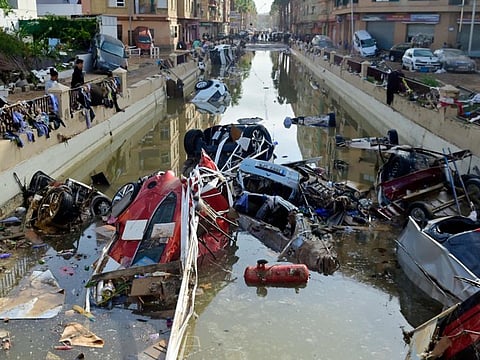Why have Spain floods killed more than 155 people?
Exceptionally violent weather caught motorists by surprise during rush hour on the roads

MADRID: Powerful storms turbo-charged by a warming planet, poor urban planning and carelessness combined with catastrophic consequences in Spain’s deadliest floods in a generation, experts told AFP.
Authorities in the European country have announced a provisional toll of 158 dead and the figure is feared to rise as rescuers search for bodies under the rubble and mud.
Exceptionally violent weather
Torrential rains drenched areas of the eastern Valencia region with a year’s worth of precipitation in a matter of hours, according to national weather service AEMET.
In Chiva, west of the coastal city of Valencia, it recorded 491 litres of rain per square metre (49.1 centimetres).
Also Read: Spain flood death toll soars to 158
The deluge was linked to a storm phenomenon common for the season where cold air travels over the Mediterranean Sea’s warm waters and forms intense rain clouds.
Scientists say human-driven climate change is increasing the temperatures of the world’s waters and increasing the ferocity of storms.
The warmer Mediterranean and time of year acted as fuel for the torrential rains in a “dramatic” cocktail attributable to climate change, said Jorge Olcina, a climate expert at Alicante University.
When storms reach such levels, they can have an effect similar to “hurricanes” or “tropical cyclones”, he added in an audio message to AFP.
Dry and artificial soils
The parched soil in the hardest-hit areas compounded the problem after Spain endured two consecutive years of intense droughts.
The ground could not absorb such a quantity of water, giving rise to flash flooding that raged through settlements.
The Valencia region is also covered with many areas where natural spaces have made way for impermeable concrete.
This urban development is “uncontrolled and ill-adapted to the natural characteristics of the territory”, amplifying the danger of powerful storms, said Pablo Aznar of the Socioeconomic Observatory of Floods and Droughts.
The population density of the Valencia region, which hosts Spain’s third-largest city of the same name with a population of almost 1.9 million inhabitants, also contributed.
Population density “was a very important factor” and posed a “challenge” to the authorities, said Aznar.
Rush hour on the roads
The timing of the storm could not have been worse as it picked up late on Tuesday when motorists were hitting the roads during the evening rush hour.
Many victims were caught by surprise in their vehicles as they returned home or on the street, with the raging waters plucking some clinging to lampposts or trees.
Such scenes could have been avoided had citizens been warned on time to allow them to shelter at home, according to Hannah Cloke, a hydrology professor at Britain’s University of Reading.
Lack of care
AEMET had issued a red warning for the Valencia region on Tuesday morning, but the civil protection service only sent its telephone alerts advising people not to leave home after 8:00 pm (1900 GMT).
But some people admitted they left home even after receiving the alert, suggesting a poor comprehension of the emergency.
Although there were “communication failures”, the responsibility is shared because Spain lacks a “culture of risk”, Aznar told AFP.
“Our collective mentality is still not sufficiently adapted to new extreme weather phenomena.”
Olcina agreed. “We have to vastly improve risk education in schools, but also in the whole population, so they know how to act in the event of an immediate risk.”
Sign up for the Daily Briefing
Get the latest news and updates straight to your inbox



